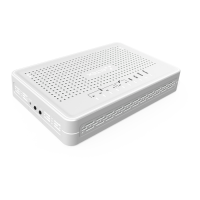
Do you have a question about the ELTEX NTU-RG-1421G-Wac and is the answer not in the manual?
| Category | Touch terminals |
|---|---|
| Model | NTU-RG-1421G-Wac |
| Manufacturer | ELTEX |
| Operating Temperature | 0°C to +40°C |
| Storage Temperature | -20°C to +60°C |
| Wi-Fi | Yes |
| Connectivity | Ethernet, Wi-Fi |
| Power Supply | 12V DC |
Notes contain important information, tips or recommendations on device operation and setup.
Warnings inform users about hazardous conditions, which may cause injuries or device damage and may lead to the device malfunctioning or data loss.
Explains the purpose of NTU-RG GPON ONT devices in providing broadcast access services.
Details the different NTU-RG series devices and their supported interfaces and features.
Lists the physical interfaces and functions supported by the NTU-RG devices.
Provides a detailed breakdown of main specifications for VoIP, Ethernet, and PON interfaces.
Describes the physical design of the NTU-RG-1421G-Wac/NTU-RG-1431G-Wac including rear panel layout.
Illustrates the rear panel of the NTU-RG-1421G-Wac and NTU-RG-1431G-Wac, detailing connectors and controls.
Explains the function of each LED indicator on the device's front panel.
Describes the functions of the physical buttons located on the device's side panel.
Describes the physical design of the NTU-RG-1421GC-Wac, including its rear panel layout.
Details the connectors and controls located on the rear panel of the NTU-RG-1421GC-Wac.
Explains the function of each LED indicator on the NTU-RG-1421GC-Wac front panel.
Details the states and corresponding device statuses for LEDs on 1421G/1431G models.
Details the states and corresponding device statuses for LEDs on the 1421GC-Wac model.
Explains the light indications for LAN ports in different operation modes.
Procedure for rebooting the device and resetting it to factory default settings.
Lists the items included in the standard NTU-RG delivery package.
Illustrates the logical architecture of the NTU-RG device, including its main components.
Details how to access the device's web interface for configuration using a browser.
Access to device status, summary, WAN, LAN, statistics, routing, ARP, DHCP, wireless stations, Wi-Fi monitor, and voice port data.
Configure LAN, NAT, Virtual Servers, Port Triggering, DMZ, Security, IP/MAC Filtering, Parental Control, URL Filter, Dynamic DNS, Print Server, DLNA, and UPnP.
Configure wireless network settings for 2.4GHz and 5GHz bands, including basic, security, bridge, and advanced options.
Manage file storage service, connected USB devices, and Samba user accounts.
Manage device settings, including restore defaults, PON password, system time, network tests, access password, system logs, software updates, and reboot.